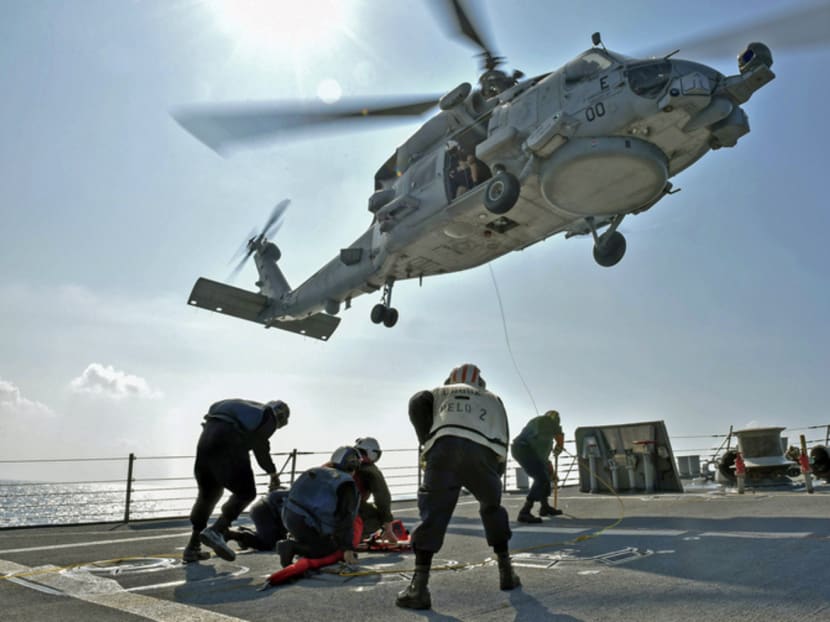China denies close encounter with US plane, blames American flights
BEIJING/WASHINGTON — China’s Ministry of Foreign Affairs yesterday urged the United States to stop close reconnaissance activities after Washington said two Chinese fighter jets carried out an “unsafe” intercept of a US military aircraft over the South China Sea.

US Navy sailors training on the deck of guided-missile destroyer USS Lassen in the South China Sea last year. Washington has accused Beijing of militarising the disputed waterway, while Beijing, in turn, has criticised increased US naval patrols and exercises in Asia. Photo: Reuters
BEIJING/WASHINGTON — China’s Ministry of Foreign Affairs yesterday urged the United States to stop close reconnaissance activities after Washington said two Chinese fighter jets carried out an “unsafe” intercept of a US military aircraft over the South China Sea.
Foreign Affairs spokesman Hong Lei told reporters at a regular briefing yesterday that the Chinese aircraft kept a safe distance from the US plane, which was flying close to China’s island province of Hainan.
“According to the related Chinese authorities, the US allegation is not true,” said Mr Hong.
He said the Chinese jets maintained “safe behaviour” and did not engage in “any dangerous action”.
“It must be pointed out that US military planes frequently carry out reconnaissance in Chinese coastal waters, seriously endangering Chinese maritime security,” he said. “We demand that the US immediately cease this type of close reconnaissance activity to avoid having this sort of incident happening again.”
The Pentagon said on late Wednesday that the incident took place in international airspace on Tuesday as the American maritime patrol aircraft carried out “a routine US patrol”.
The encounter comes a week after China scrambled fighter jets as a US Navy ship sailed close to a disputed reef in the South China Sea. It also came days after China accused the US of distorting facts in a report on Beijing’s defence policy and warned Washington it had “severely damaged” trust between the superpowers.
In an annual report to Congress, the Pentagon said Beijing had been using “coercive tactics” to assert its claims in the South China Sea.
China claims most of the South China Sea, through which US$5 trillion (S$6.9 trillion) in shipborne trade passes every year. The Philippines, Vietnam, Malaysia, Taiwan and Brunei have overlapping claims.
Washington has accused Beijing of militarising the disputed waterway by creating artificial islands, while Beijing, in turn, has criticised increased US naval patrols and exercises in Asia.
The Pentagon statement said yesterday the Department of Defense was addressing the issue through military and diplomatic channels.
The Pentagon has yet to release the precise location of the encounter.
“This is exactly the type of irresponsible and dangerous intercepts that the air-to-air annex to Cues is supposed to prevent,” said Mr Greg Poling, director of the Asia Maritime Transparency Initiative at Washington’s Center for Strategic and International Studies think-tank, using the acronym for the Code for Unplanned Encounters at Sea, an agreement that governs air and naval encounters.
Mr Poling said either some part of China’s air force “hadn’t gotten the message”, or it was meant as a signal of displeasure with recent US freedom-of-navigation actions in the South China Sea. “If the latter, it would be very disappointing to find China sacrificing the Cues annex for political gamesmanship,” he said.
Mr Zhang Baohui, a security expert at Hong Kong’s Lingnan University, said he believed the encounter highlighted the limitation of Cues and shows that Chinese pilots would still fly close to US surveillance planes if needed. “Frankly, we’re always going to see these kinds of incidents as China will always put the priority on national security over something like Cues whenever it feels its interests are directly threatened,” he said.
The Cues protocol was agreed between the US, China, and eight Association of South-east Asian Nations countries, among others, at the 14th Western Pacific Naval Symposium in 2014. While Cues is not legally binding, it is an agreement upon which the participating nations have a standardised protocol of safety procedures, basic communications and basic manoeuvring instructions to follow for naval ships and aircraft during unplanned encounters at sea.
Singapore Minister for Foreign Affairs Vivian Balakrishnan said in March that Singapore had mooted the idea of expanding Cues to cover both naval and coastguard vessels in order to avoid accidents or miscalculations that could lead to conflict, hostilities or loss of life. AGENCIES






